2005 RENAULT MEGANE engine
[x] Cancel search: enginePage 97 of 250
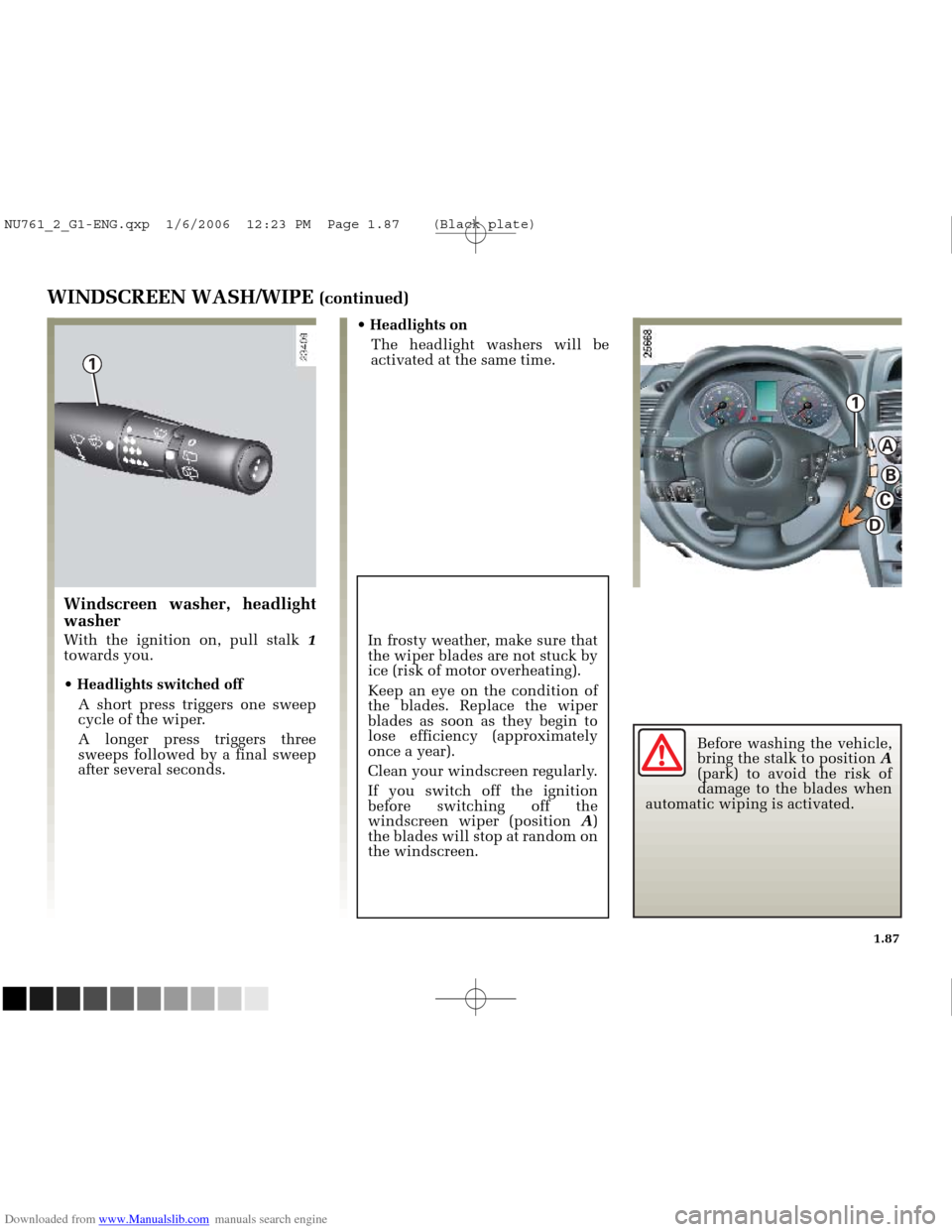
Downloaded from www.Manualslib.com manuals search engine
1
1
C
B
A
D
NU761_2_G1-FRA.qxd 10/11/05 15:55 Page 1.87
1.87
Before washing the vehicle,
bring the stalk to position A
(park) to avoid the risk of
damage to the blades when
automatic wiping is activated.
WINDSCREEN WASH/WIPE (continued)
In frosty weather, make sure that
the wiper blades are not stuck by
ice (risk of motor overheating).
Keep an eye on the condition of
the blades. Replace the wiper
blades as soon as they begin to
lose efficiency (approximately
once a year).
Clean your windscreen regularly.
If you switch off the ignition
before switching off the
windscreen wiper (position A)
the blades will stop at random on
the windscreen.
Windscreen washer, headlight
washer
With the ignition on, pull stalk 1
towards you.
Headlights switched off
A short press triggers one sweep
cycle of the wiper.
A longer press triggers three
sweeps followed by a final sweep
after several seconds. Headlights on
The headlight washers will be
activated at the same time.
NU761_2_G1-ENG.qxp 1/6/2006 12:23 PM Page 1.87 (Black plate)
Page 98 of 250
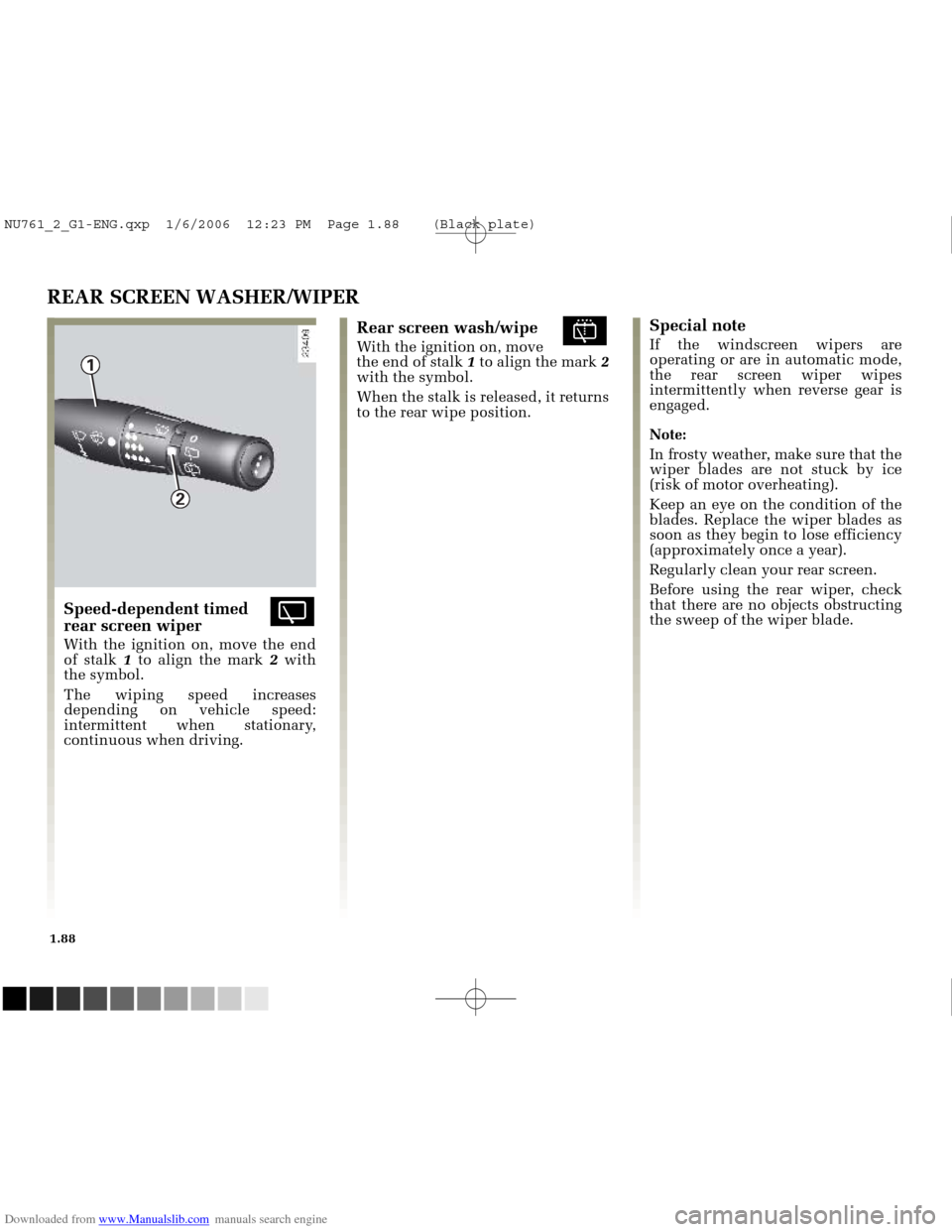
Downloaded from www.Manualslib.com manuals search engine
1
2
NU761_2_G1-FRA.qxd 10/11/05 15:55 Page 1.88
1.88
REAR SCREEN WASHER/WIPER
Speed-dependent timed erear screen wiper
With the ignition on, move the end
of stalk 1to align the mark 2with
the symbol.
The wiping speed increases
depending on vehicle speed:
intermittent when stationary,
continuous when driving.
Rear screen wash/wipe jWith the ignition on, move
the end of stalk 1to align the mark 2
with the symbol.
When the stalk is released, it returns
to the rear wipe position.
Special note
If the windscreen wipers are
operating or are in automatic mode,
the rear screen wiper wipes
intermittently when reverse gear is
engaged.
Note:
In frosty weather, make sure that the
wiper blades are not stuck by ice
(risk of motor overheating).
Keep an eye on the condition of the
blades. Replace the wiper blades as
soon as they begin to lose efficiency
(approximately once a year).
Regularly clean your rear screen.
Before using the rear wiper, check
that there are no objects obstructing
the sweep of the wiper blade.
NU761_2_G1-ENG.qxp 1/6/2006 12:23 PM Page 1.88 (Black plate)
Page 99 of 250
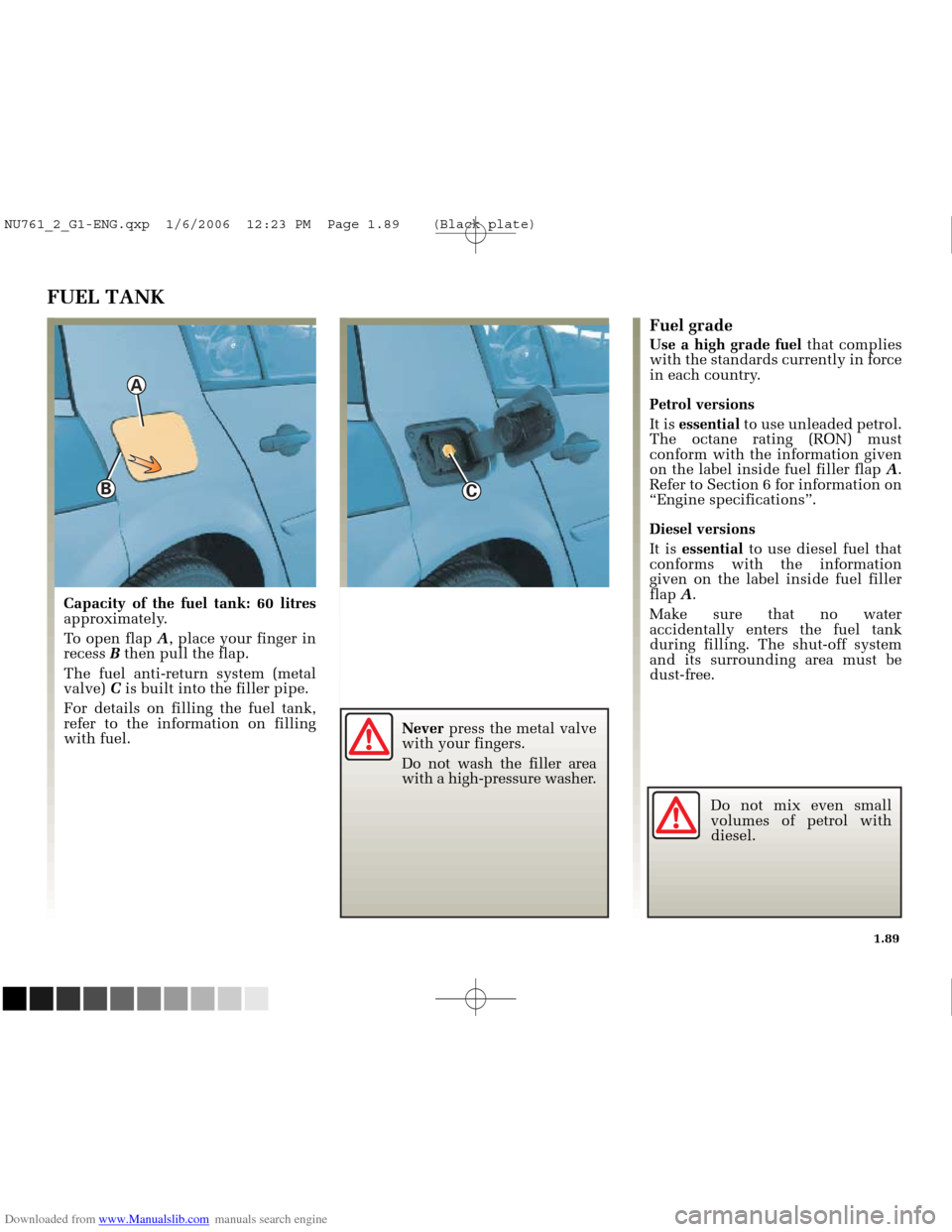
Downloaded from www.Manualslib.com manuals search engine
A
B
C
NU761_2_G1-FRA.qxd 10/11/05 15:55 Page 1.89
1.89
Do not mix even small
volumes of petrol with
diesel.
Never
press the metal valve
with your fingers.
Do not wash the filler area
with a high-pressure washer.
FUEL TANK
Capacity of the fuel tank: 60 litres
approximately.
To open flap A, place your finger in
recess Bthen pull the flap.
The fuel anti-return system (metal
valve) Cis built into the filler pipe.
For details on filling the fuel tank,
refer to the information on filling
with fuel.
Fuel grade
Use a high grade fuel that complies
with the standards currently in force
in each country.
Petrol versions
It is essential to use unleaded petrol.
The octane rating (RON) must
conform with the information given
on the label inside fuel filler flap A.
Refer to Section 6 for information on
“Engine specifications”.
Diesel versions
It is essential to use diesel fuel that
conforms with the information
given on the label inside fuel filler
flap A.
Make sure that no water
accidentally enters the fuel tank
during filling. The shut-off system
and its surrounding area must be
dust-free.
NU761_2_G1-ENG.qxp 1/6/2006 12:23 PM Page 1.89 (Black plate)
Page 100 of 250
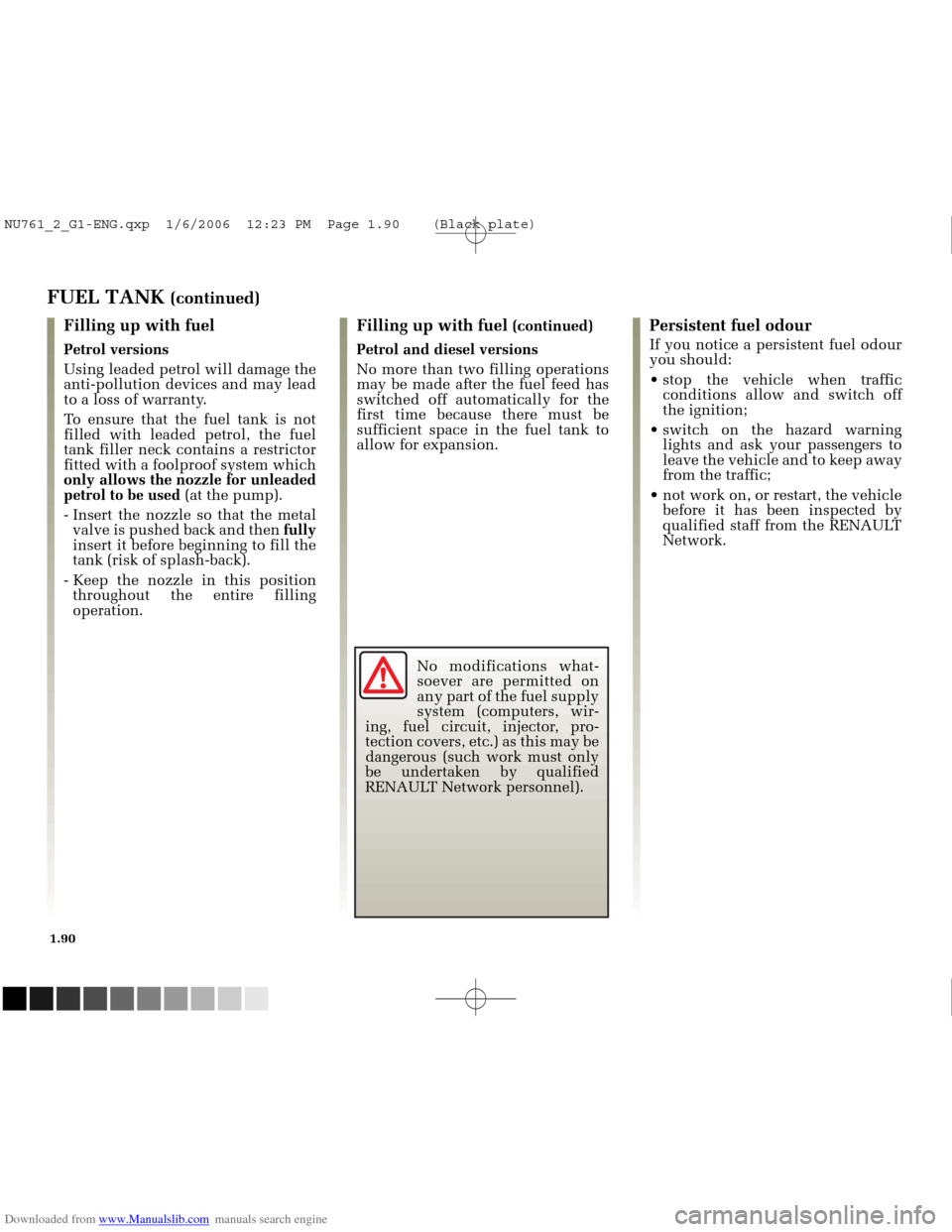
Downloaded from www.Manualslib.com manuals search engine
NU761_2_G1-FRA.qxd 10/11/05 15:55 Page 1.90
1.90
No modifications what-
soever are permitted on
any part of the fuel supply
system (computers, wir-
ing, fuel circuit, injector, pro-
tection covers, etc.) as this may be
dangerous (such work must only
be undertaken by qualified
RENAULT Network personnel).
FUEL TANK (continued)
Filling up with fuel
Petrol versions
Using leaded petrol will damage the
anti-pollution devices and may lead
to a loss of warranty.
To ensure that the fuel tank is not
filled with leaded petrol, the fuel
tank filler neck contains a restrictor
fitted with a foolproof system which
only allows the nozzle for unleaded
petrol to be used (at the pump).
- Insert the nozzle so that the metal valve is pushed back and then fully
insert it before beginning to fill the
tank (risk of splash-back).
- Keep the nozzle in this position throughout the entire filling
operation.
Persistent fuel odour
If you notice a persistent fuel odour
you should:
stop the vehicle when traffic conditions allow and switch off
the ignition;
switch on the hazard warning lights and ask your passengers to
leave the vehicle and to keep away
from the traffic;
not work on, or restart, the vehicle before it has been inspected by
qualified staff from the RENAULT
Network.
Filling up with fuel (continued)
Petrol and diesel versions
No more than two filling operations
may be made after the fuel feed has
switched off automatically for the
first time because there must be
sufficient space in the fuel tank to
allow for expansion.
NU761_2_G1-ENG.qxp 1/6/2006 12:23 PM Page 1.90 (Black plate)
Page 101 of 250
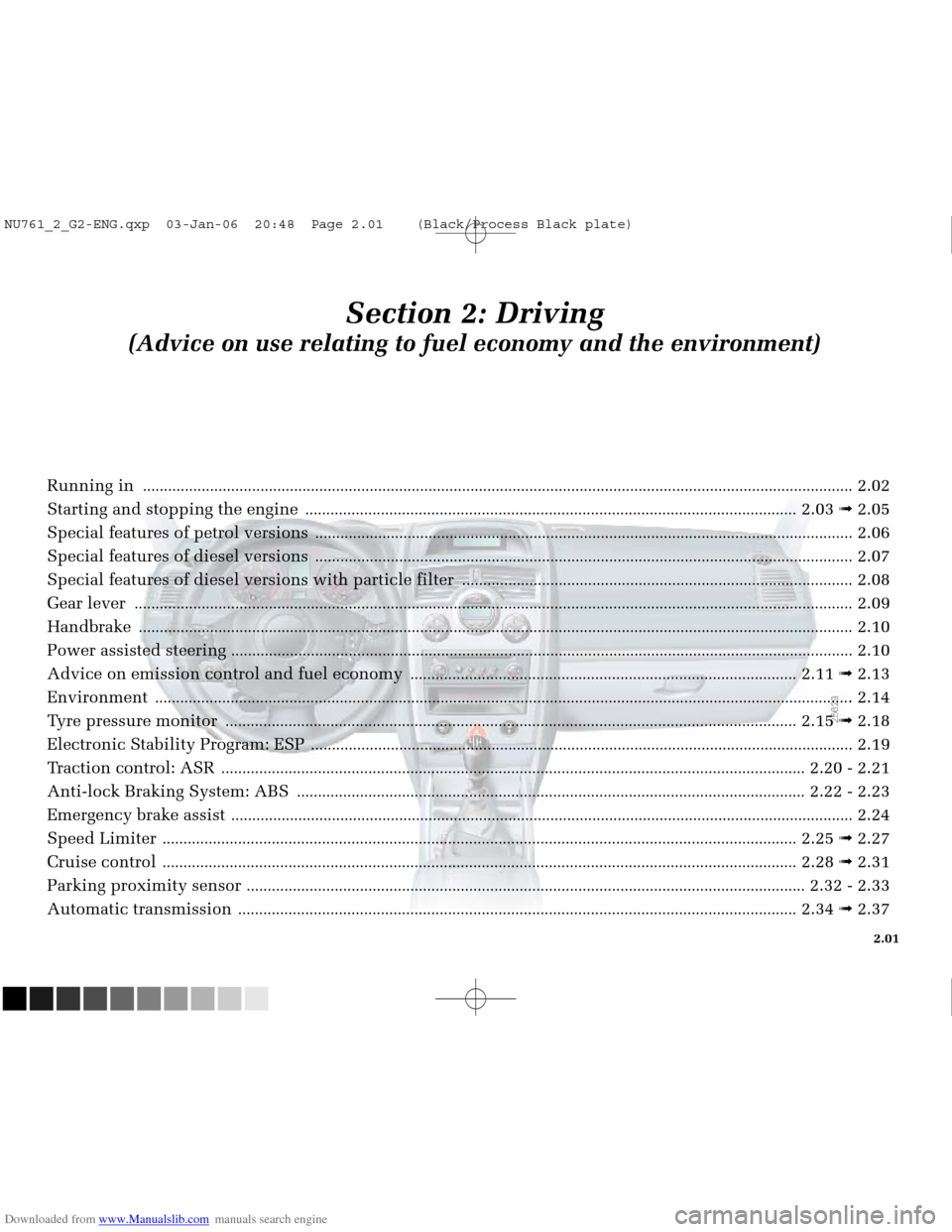
Downloaded from www.Manualslib.com manuals search engine
NU761_2_G2-FRA.qxd 4/11/05 10:48 Page 2.01
2.01
Section 2: Driving
(Advice on use relating to fuel economy and the environment)
Running in ........................................................................\
.................................................................................................2.02
Starting and stopping the engine
........................................................................\
.............................................2.03 ➟2.05
Special features of petrol versions
........................................................................\
....................................................... .2.06
Special features of diesel versions
........................................................................\
....................................................... .2.07
Special features of diesel versions with particle filter
........................................................................\
.....................2.08
Gear lever
........................................................................\
....................................................... ............................................2.09
Handbrake
........................................................................\
....................................................... ...........................................2.10
Power assisted steering
........................................................................\
....................................................... .....................2.10
Advice on emission control and fuel economy
........................................................................\
....................2.11 ➟2.13
Environment
........................................................................\
....................................................... ....................................... 2.14
Tyre pressure monitor
........................................................................\
....................................................... .........2.15 ➟2.18
Electronic Stability Program: ESP
........................................................................\
....................................................... ..2.19
Traction control: ASR
........................................................................\
....................................................... ............2.20 - 2.21
Anti-lock Braking System: ABS
........................................................................\
.................................................2.22 - 2.23
Emergency brake assist
........................................................................\
....................................................... .....................2.24
Speed Limiter
........................................................................\
....................................................... ........................2.25 ➟2.27
Cruise control
........................................................................\
....................................................... ........................2.28 ➟2.31
Parking proximity sensor
........................................................................\
....................................................... ......2.32 - 2.33
Automatic transmission
........................................................................\
....................................................... ......2.34 ➟2.37
NU761_2_G2-ENG.qxp 03-Jan-06 20:48 Page 2.01 (Black/Process Black\
plate)
Page 102 of 250
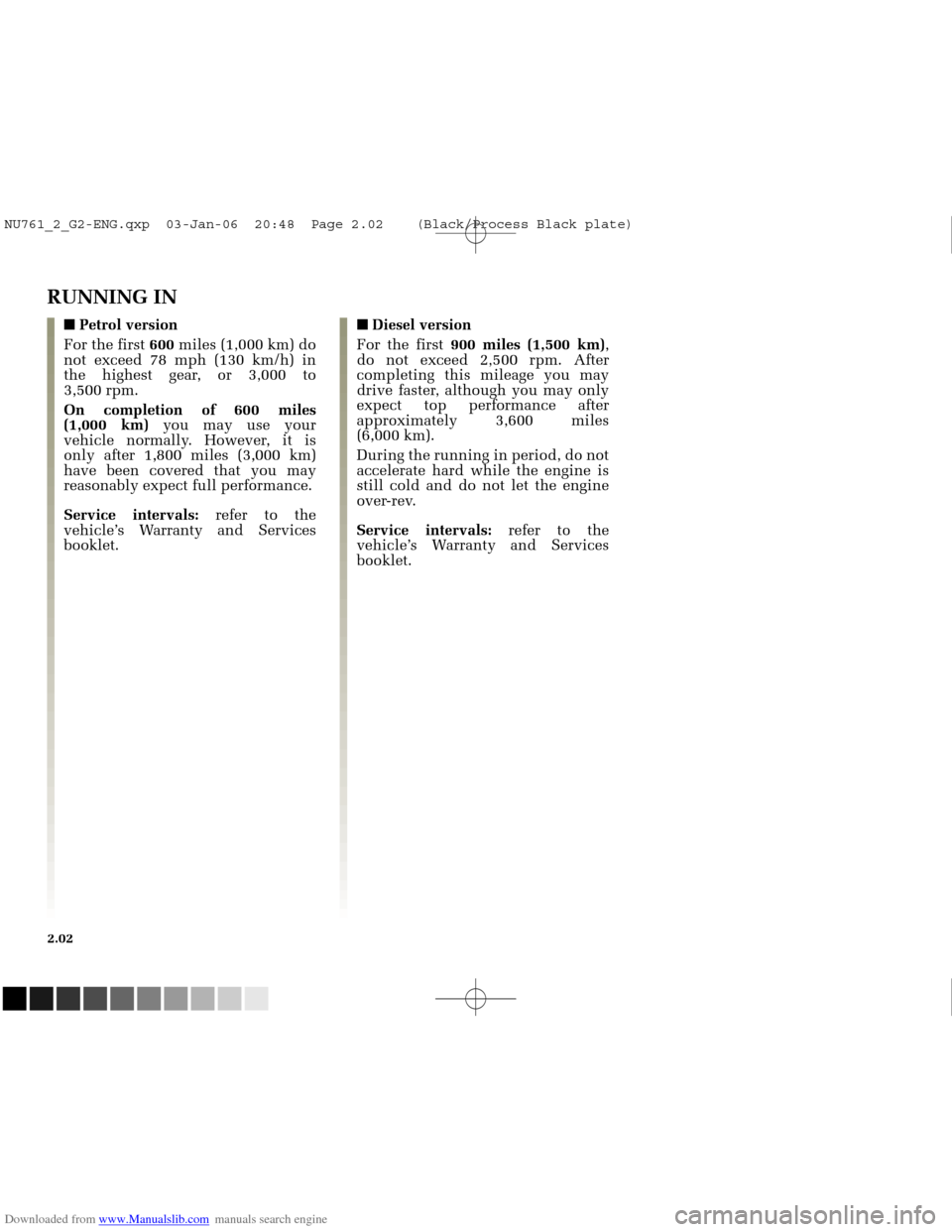
Downloaded from www.Manualslib.com manuals search engine
NU761_2_G2-FRA.qxd 4/11/05 10:48 Page 2.02
2.02
RUNNING IN
■Petrol version
For the first 600 miles (1,000 km) do
not exceed 78 mph (130 km/h) in
the highest gear, or 3,000 to
3,500 rpm.
On completion of 600 miles
(1,000 km) you may use your
vehicle normally. However, it is
only after 1,800 miles (3,000 km)
have been covered that you may
reasonably expect full performance.
Service intervals: refer to the
vehicle’s Warranty and Services
booklet. ■
Diesel version
For the first 900 miles (1,500 km) ,
do not exceed 2,500 rpm. After
completing this mileage you may
drive faster, although you may only
expect top performance after
approximately 3,600 miles
(6,000 km).
During the running in period, do not
accelerate hard while the engine is
still cold and do not let the engine
over-rev.
Service intervals: refer to the
vehicle’s Warranty and Services
booklet.
NU761_2_G2-ENG.qxp 03-Jan-06 20:48 Page 2.02 (Black/Process Black\
plate)
Page 103 of 250
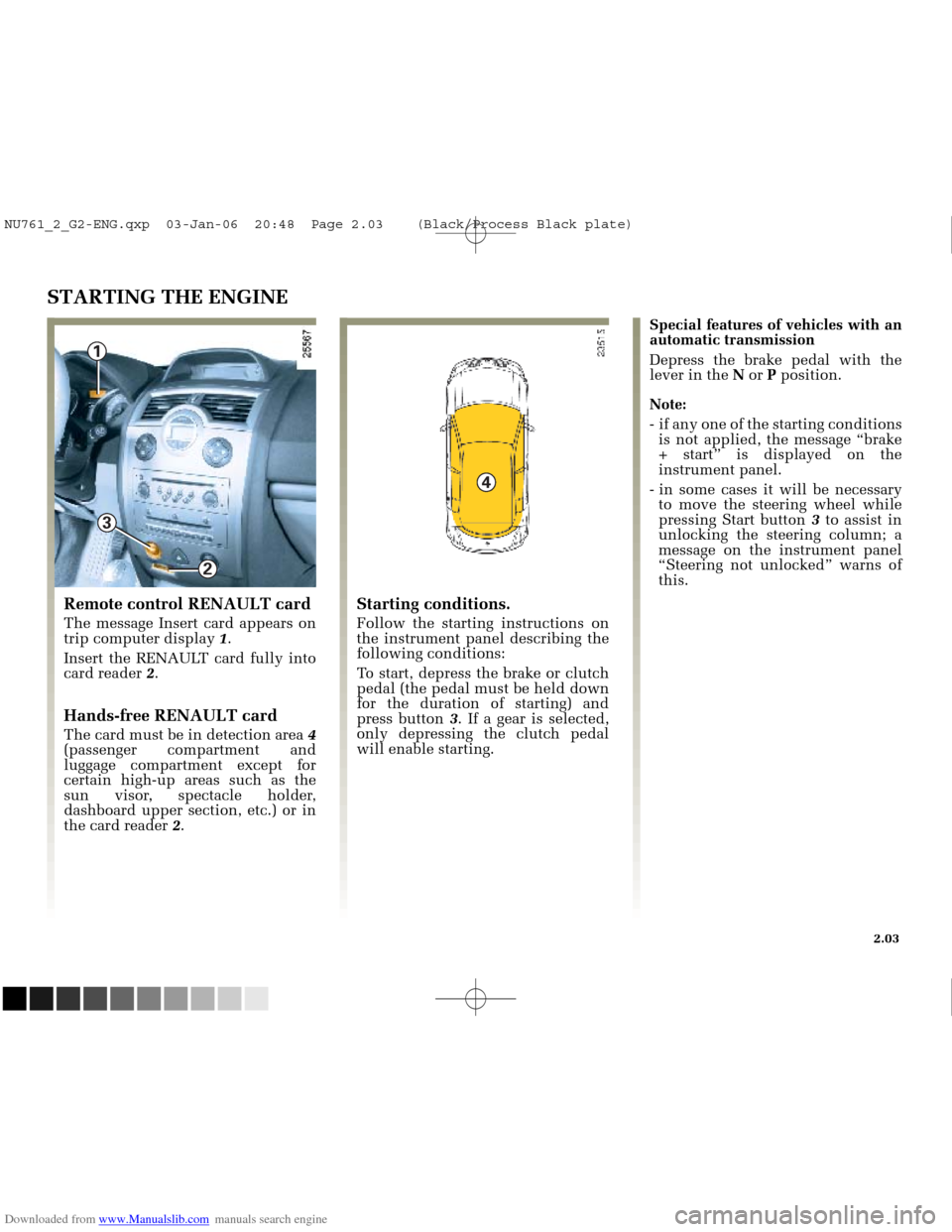
Downloaded from www.Manualslib.com manuals search engine
1
2
3
4
NU761_2_G2-FRA.qxd 4/11/05 10:48 Page 2.03
STARTING THE ENGINE
Special features of vehicles with an
automatic transmission
Depress the brake pedal with the
lever in the Nor Pposition.
Note:
- if any one of the starting conditions is not applied, the message “brake
+ start” is displayed on the
instrument panel.
- in some cases it will be necessary to move the steering wheel while
pressing Start button 3to assist in
unlocking the steering column; a
message on the instrument panel
“Steering not unlocked” warns of
this.
Remote control RENAULT card
The message Insert card appears on
trip computer display 1.
Insert the RENAULT card fully into
card reader 2.
Hands-free RENAULT card
The card must be in detection area 4
(passenger compartment and
luggage compartment except for
certain high-up areas such as the
sun visor, spectacle holder,
dashboard upper section, etc.) or in
the card reader 2.
Starting conditions.
Follow the starting instructions on
the instrument panel describing the
following conditions:
To start, depress the brake or clutch
pedal (the pedal must be held down
for the duration of starting) and
press button 3. If a gear is selected,
only depressing the clutch pedal
will enable starting.
2.03
NU761_2_G2-ENG.qxp 03-Jan-06 20:48 Page 2.03 (Black/Process Black\
plate)
Page 104 of 250
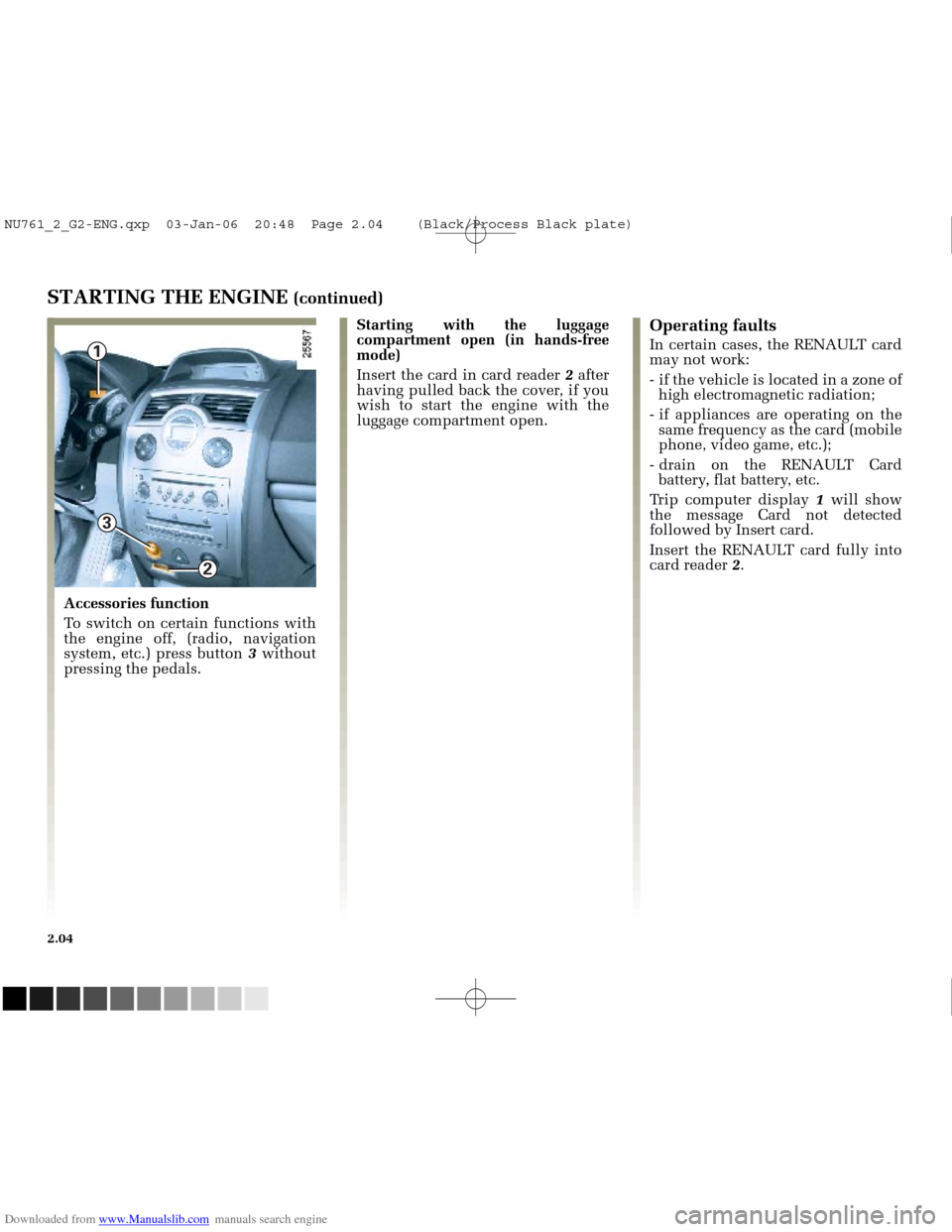
Downloaded from www.Manualslib.com manuals search engine
1
2
3
NU761_2_G2-FRA.qxd 4/11/05 10:48 Page 2.04
2.04
STARTING THE ENGINE (continued)
Starting with the luggage
compartment open (in hands-free
mode)
Insert the card in card reader 2after
having pulled back the cover, if you
wish to start the engine with the
luggage compartment open.Operating faults
In certain cases, the RENAULT card
may not work:
- if the vehicle is located in a zone of high electromagnetic radiation;
- if appliances are operating on the same frequency as the card (mobile
phone, video game, etc.);
- drain on the RENAULT Card battery, flat battery, etc.
Trip computer display 1 will show
the message Card not detected
followed by Insert card.
Insert the RENAULT card fully into
card reader 2.
Accessories function
To switch on certain functions with
the engine off, (radio, navigation
system, etc.) press button 3 without
pressing the pedals.
NU761_2_G2-ENG.qxp 03-Jan-06 20:48 Page 2.04 (Black/Process Black\
plate)